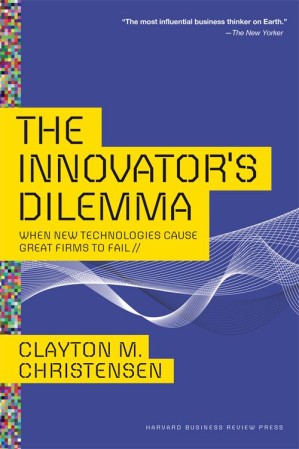Insights from The Innovator's Dilemma: When New Technologies Cause Great Firms to Fail
The Innovator's Dilemma by Clayton M. Christensen is a seminal work that explores why successful companies often fail when confronted with disruptive technological change. Christensen, through extensive research and real-world examples, provides a framework for understanding the principles of disruptive innovation and offers strategies for managing technological transitions.

Summary
Part One: Why Great Companies Can Fail
Chapter 1: How Can Great Firms Fail? Insights from the Hard Disk Drive Industry
Christensen begins by examining the hard disk drive industry, a field characterised by rapid technological changes. He introduces the concept of disruptive technologies innovations that initially offer lower performance but eventually surpass existing technologies. Established firms often fail because they focus on sustaining technologies that improve existing products for their current customers.
Chapter 2: Value Networks and the Impetus to Innovate
Value networks define the context within which a firm identifies and responds to customers' needs, solves problems, procures input, reacts to competitors, and strives for profit. Companies operate within their existing value networks, which makes it challenging to adopt disruptive technologies that fall outside these networks.
Chapter 3: Disruptive Technological Change in the Mechanical Excavator Industry
The mechanical excavator industry provides another example where leading firms were overtaken by newcomers employing disruptive technologies. Christensen emphasises that disruptive innovations often appear less profitable initially, which is why established firms are reluctant to invest in them.
Chapter 4: What Goes Up, Can’t Go Down
This chapter discusses the limits of sustaining technologies and how companies' focus on high-end customers often leads to over-engineering, which opens the door for simpler, more affordable disruptive technologies to capture the low end of the market and gradually move up.
Part Two: Managing Disruptive Technological Change
Chapter 5: Give Responsibility for Disruptive Technologies to Organisations Whose Customers Need Them
Christensen argues that successful companies should create autonomous organisations to develop disruptive technologies. These new units can operate independently and are free from the constraints and biases of the parent company.
Chapter 6: Match the Size of the Organization to the Size of the Market
Large companies struggle to invest in small, emerging markets. By creating smaller, focused organizations, companies can better address these new markets' needs and grow alongside them.
Chapter 7: Discovering New and Emerging Markets
Established firms often fail to recognise and enter new markets early. Christensen suggests that companies should embrace uncertainty and adopt a discovery-driven planning approach, which allows for flexibility and learning.
Chapter 8: How to Appraise Your Organisation’s Capabilities and Disabilities
Organisations have inherent capabilities and disabilities based on their existing processes and values. Christensen advises managers to assess these attributes to determine whether their organisation is suited to tackle new disruptive challenges.
Chapter 9: Performance Provided, Market Demand, and the Product Life Cycle
Technological progress can outstrip market demand, leading to a mismatch between what companies can produce and what customers actually need. This chapter explores how companies can anticipate and adapt to these shifts.
Chapter 10: Managing Disruptive Technological Change: A Case Study
Christensen provides a detailed case study on the electric vehicle industry, illustrating how companies can strategically manage disruptive technologies by aligning their organisation and resources with the unique demands of these emerging markets.
Chapter 11: The Dilemmas of Innovation: A Summary
The final chapter summarizes the principles of disruptive innovation and emphasises the importance of understanding when to follow conventional management practices and when to deviate from them to embrace disruptive changes.
Key Takeaways
- Disruptive vs. Sustaining Technologies: Disruptive technologies initially underperform compared to existing products but eventually capture mainstream markets.
- Value Networks: Companies operate within value networks that define their business models and customer relationships, making it difficult to adopt disruptive technologies.
- Autonomous Organisations: Creating independent units to explore disruptive technologies can help established firms innovate without being constrained by their existing processes and values.
- Small Market Entry: Large companies should create smaller, focused units to enter and grow with emerging markets.
- Discovery-Driven Planning: Embracing uncertainty and flexibility allows companies to adapt and succeed in new markets.
- Organisational Capabilities and Disabilities: Assessing an organisation's strengths and weaknesses is crucial for addressing new disruptive challenges.
Personal Reflections
Reading "The Innovator's Dilemma" has provided me with a deeper understanding of why well-managed companies often fail in the face of disruptive technological change. Christensen's insights have made me more aware of the importance of being open to new ideas and creating flexible structures within organisations to foster innovation.
Conclusion
Clayton M. Christensen's "The Innovator's Dilemma" is an essential read for anyone interested in innovation and business strategy. It offers a comprehensive framework for understanding the dynamics of disruptive technologies and provides actionable insights for managers seeking to navigate these challenges. By embracing the principles of disruptive innovation, companies can better position themselves to thrive in an ever-changing technological landscape.